Preventing and anticipating communication conflicts is one of the major challenges facing companies as they strive to improve their performance. Impossible to avoid at all times, disagreements undermine employee effectiveness on a daily basis. The Karpman triangle is an ideal tool for avoiding them.

The quest for performance inherent in the company requires a communication effective, especially between employees. However, personality differences can lead to misunderstandings and incompatibilities that are difficult to reconcile in a professional environment, and can become a source of conflict. The Karpman Process Model® is a tried and tested method for anticipating and managing this type of blockage. Renée Chartier, professional coach and certified Karpman Process Model® trainer, talks to us about it.
"Sorry, I won't be able to present this tomorrow. I know I should have told you about it before! I'm sorry! I'm terrible!"
- "Knowing you, I suspected as much!"
OR, "I understand! I'll be up all night working on your slides: you'll get them tomorrow and you can present your case!
Without realising it, we often talk like this.
Is it positive? No. A peremptory way of communicating, just like constant complaining, negativity..., tends to generate stress It steals our energy, but it also slows down our performance. So what can we do about it? Like any dysfunction, we need to deconstruct the process in order to find a solution. And when it comes to communication, identifying and putting words to the pitfalls or blockages is the first step in overcoming them.
Help, Dr Karpman!
The origins of the Karpman Process Model
Stephen Karpman is a psychiatrist who has spent virtually his entire career working alongside Eric Berne, the founder of transactional analysis.
He works on the psychological games we have been playing unknowingly since childhood, the little manoeuvres of everyday life and other communication traps. Dr Karpman then brought to light a "dramatic triangle and its processes" which illustrates communicational conflicts and presents the roles of Persecutor-Saviour-Victim inherent in conflict situations. This triangle is the representation of a psychological game between interlocutors capable of alternately playing these different roles.
Based on his book The dramatic triangle which summarises his message, his theory becomes the Karpman Process Model® (KPM).
What is the Karpman Process Model® (KPM)?
The Karpman triangle (or dramatic triangle) is a transactional analysis tool that represents one of the manipulation games in communication. Dr Karpman combines the dramatic triangle and the compassionate triangle, which together become a tool for avoiding some of the pitfalls of communication and learning to speak healthily. With the Karpman Process Model®, we learn to unravel the mechanisms and manipulations of everyday life (via the dramatic triangle) and to thwart them (via the compassionate triangle).
How does it work?
When we're under stress, we tend to take on a different role. role to try and solve our problems. Depending on our personality or the dynamics of the exchange, we :
- use aggression and violence in the role of persecutor ;
- help a colleague who hasn't asked us for anything, in the role of saviour ;
- we lament in the role of victimpraying that someone will come and save us.
Sometimes we play alone, sometimes we invite our friends and colleagues to take on one of these roles too!

With the point downwards, the Karpman triangle highlights the unstable nature of a conflict situation and reflects the tensions that rise and the conflicts that ensue!
This toxicity of dialogue, whether internal (dialogue with oneself) or relational, can be the lever for criminal and traumatic behaviour (harassment) or lead to situations of profound distress (addictions).
Why do we play these psychological games?
We play these psychological games because we're human, and because we've been playing them unknowingly since childhood, in our families, at school, university and at work.
How do you get out of the Karpman triangle?
Helping employees to break out of the communication patterns described by the Karpman triangle is important if companies are to improve performance and efficiency. Roles and the scenarios they generate shape exchanges and relationships between employees. And professional relationships can only exacerbate this type of role, particularly because of hierarchical links. There are three steps to getting out of the Karpman triangle:
- OBSERVE: take a step back, identify your own behaviour and that of others through observation, avoid reacting too quickly;
- IDENTIFY THE TRAP: what roles do they play? What energy does it generate in you and the people you're talking to?
- RESPOND AND REPLACE: the roles described by Karpman's triangle with the P+, V+, S+ behaviour of the compassionate triangle.
The compassionate triangle
The aim of the compassionate triangle, the counterpart to the dramatic triangle, is to help you learn to avoid these traps by using a logic of power, compassion and 'compassion'.empathy. Identifying the pitfalls gives you the ability to stop playing games and react positively.
And how is the training organised?
Integrating these concepts is easy, but making them your own takes time.
That's why the course takes place over two days:
- a day devoted to the pitfalls of communication: roles, invitations, sabotage strategies. To learn how to detect them, there's nothing like playing! (taking on the role of persecutor, inviting your colleague to take on the role of victim, etc.);
- a day devoted to the practice of the compassionate triangle and healthy communication.
Insofar as we all have these underlying roles within us, this training course is aimed at all managers and employees. The Karpman Process Model® does indeed have a role to play in preventing conflict and psychosocial risks in the workplace, for example by being integrated into a Prevention-Safety plan.
Using the Karpman Process Model® means learning to talk and live differently. It means understanding that healthy communication is essential to well-being and quality of life.
As Stephen Karpman said: " To live happily, let's not play games. "


